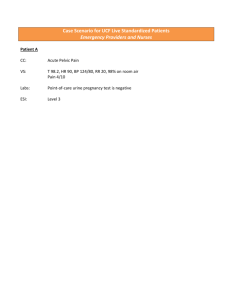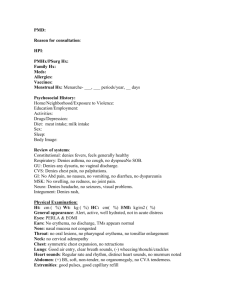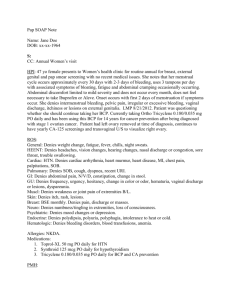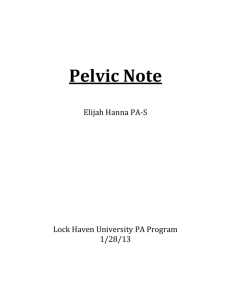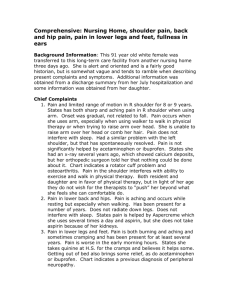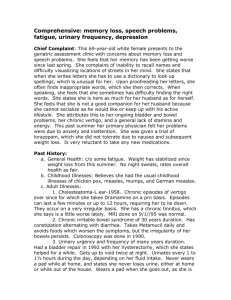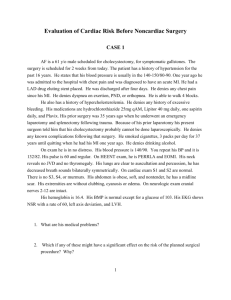Post-Partum/Post
advertisement
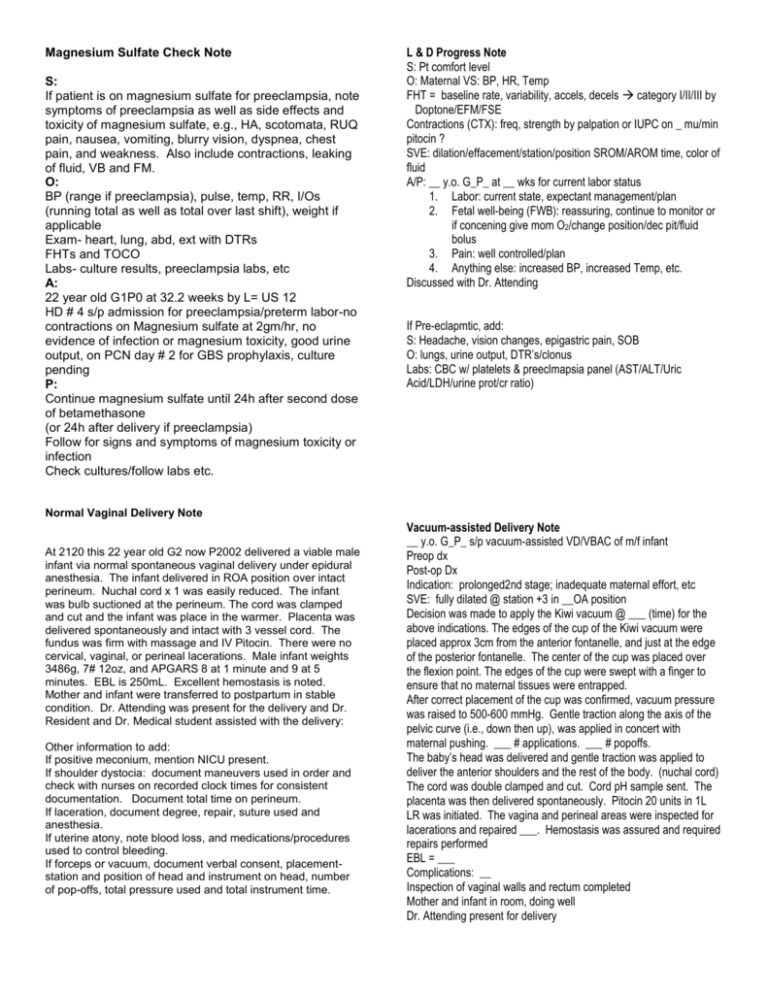
Magnesium Sulfate Check Note S: If patient is on magnesium sulfate for preeclampsia, note symptoms of preeclampsia as well as side effects and toxicity of magnesium sulfate, e.g., HA, scotomata, RUQ pain, nausea, vomiting, blurry vision, dyspnea, chest pain, and weakness. Also include contractions, leaking of fluid, VB and FM. O: BP (range if preeclampsia), pulse, temp, RR, I/Os (running total as well as total over last shift), weight if applicable Exam- heart, lung, abd, ext with DTRs FHTs and TOCO Labs- culture results, preeclampsia labs, etc A: 22 year old G1P0 at 32.2 weeks by L= US 12 HD # 4 s/p admission for preeclampsia/preterm labor-no contractions on Magnesium sulfate at 2gm/hr, no evidence of infection or magnesium toxicity, good urine output, on PCN day # 2 for GBS prophylaxis, culture pending P: Continue magnesium sulfate until 24h after second dose of betamethasone (or 24h after delivery if preeclampsia) Follow for signs and symptoms of magnesium toxicity or infection Check cultures/follow labs etc. L & D Progress Note S: Pt comfort level O: Maternal VS: BP, HR, Temp FHT = baseline rate, variability, accels, decels category I/II/III by Doptone/EFM/FSE Contractions (CTX): freq, strength by palpation or IUPC on _ mu/min pitocin ? SVE: dilation/effacement/station/position SROM/AROM time, color of fluid A/P: __ y.o. G_P_ at __ wks for current labor status 1. Labor: current state, expectant management/plan 2. Fetal well-being (FWB): reassuring, continue to monitor or if concening give mom O2/change position/dec pit/fluid bolus 3. Pain: well controlled/plan 4. Anything else: increased BP, increased Temp, etc. Discussed with Dr. Attending If Pre-eclapmtic, add: S: Headache, vision changes, epigastric pain, SOB O: lungs, urine output, DTR’s/clonus Labs: CBC w/ platelets & preeclmapsia panel (AST/ALT/Uric Acid/LDH/urine prot/cr ratio) Normal Vaginal Delivery Note At 2120 this 22 year old G2 now P2002 delivered a viable male infant via normal spontaneous vaginal delivery under epidural anesthesia. The infant delivered in ROA position over intact perineum. Nuchal cord x 1 was easily reduced. The infant was bulb suctioned at the perineum. The cord was clamped and cut and the infant was place in the warmer. Placenta was delivered spontaneously and intact with 3 vessel cord. The fundus was firm with massage and IV Pitocin. There were no cervical, vaginal, or perineal lacerations. Male infant weights 3486g, 7# 12oz, and APGARS 8 at 1 minute and 9 at 5 minutes. EBL is 250mL. Excellent hemostasis is noted. Mother and infant were transferred to postpartum in stable condition. Dr. Attending was present for the delivery and Dr. Resident and Dr. Medical student assisted with the delivery: Other information to add: If positive meconium, mention NICU present. If shoulder dystocia: document maneuvers used in order and check with nurses on recorded clock times for consistent documentation. Document total time on perineum. If laceration, document degree, repair, suture used and anesthesia. If uterine atony, note blood loss, and medications/procedures used to control bleeding. If forceps or vacuum, document verbal consent, placementstation and position of head and instrument on head, number of pop-offs, total pressure used and total instrument time. Vacuum-assisted Delivery Note __ y.o. G_P_ s/p vacuum-assisted VD/VBAC of m/f infant Preop dx Post-op Dx Indication: prolonged2nd stage; inadequate maternal effort, etc SVE: fully dilated @ station +3 in __OA position Decision was made to apply the Kiwi vacuum @ ___ (time) for the above indications. The edges of the cup of the Kiwi vacuum were placed approx 3cm from the anterior fontanelle, and just at the edge of the posterior fontanelle. The center of the cup was placed over the flexion point. The edges of the cup were swept with a finger to ensure that no maternal tissues were entrapped. After correct placement of the cup was confirmed, vacuum pressure was raised to 500-600 mmHg. Gentle traction along the axis of the pelvic curve (i.e., down then up), was applied in concert with maternal pushing. ___ # applications. ___ # popoffs. The baby’s head was delivered and gentle traction was applied to deliver the anterior shoulders and the rest of the body. (nuchal cord) The cord was double clamped and cut. Cord pH sample sent. The placenta was then delivered spontaneously. Pitocin 20 units in 1L LR was initiated. The vagina and perineal areas were inspected for lacerations and repaired ___. Hemostasis was assured and required repairs performed EBL = ___ Complications: __ Inspection of vaginal walls and rectum completed Mother and infant in room, doing well Dr. Attending present for delivery OB Discharge Dictation Patient Name Patient MR# Resident Name Attending Name Date of Admission: Date of Discharge: Admitting Diagnosis: 1. IUP at __ weeks and __ days 2. Diagnosis on admission: ( preeclampsia, PTL, spontaneous labor, PPROM) 3. Other diagnoses: (all other medical problems present at admission, including diabetes, hypertension, fetal anomalies, anemia, obesity, etc) Discharge Diagnosis: 1. IUP at __ weeks and __ days 2. Diagnosis on admission: (after each diagnosis, resolved, improved, treated, or remove diagnosis if ruled out) 3. Other diagnoses: (all other medical problems present at time of discharge) *Need to specify if there is a change in primary diagnosis from admission to discharge, (mild preeclampsia to HELLP syndrome) Procedures Performed: EFM, ultrasound, epidural, vaginal delivery, or cesarean section Complications: transfusion reaction, bladder laceration, delivery lacerations, etc Consultations: Maternal fetal medicine, gastroenterology, cardiology, etc History of Present Illness: Patient is a __ year old G_ P_/_/_/_ at __ weeks and __ days by LMP = US at __ weeks. LMP:__/__/__, EDD: __/__/__. She presented to Sinai hospital with a complaint of ______. Describe presentation of Illness, including evaluation and labs elsewhere. If transferred from other facility, specify the name of the provider, hospital, and route of transfer, i.e., by helicopter, ambulance, etc. PNC: Provider, facility or no prenatal care. Prenatal Labs: On admission and discharge Past OB History: Year of delivery, vaginal or cesarean, birth weight, complications, location PMHx: PSHx: Social History: Family History: Pertinent to HPI: ROS: Pertinent to HPI Hospital Care: What happened during her stay, how did we diagnose/resolve each of her admitting diagnoses day by day during hospitalization. (labs/tests/medications given) Disposition: Discharge: Home, left AMA or other Follow up appointments: Where, when, and if patient needed to call for appointment Instructions: Activity, diet and precautions. Discharge medications: include name, dose, frequency, and route. INCLUDE CONTRACEPTION if started in hospital (Depo) Please state if face to face discharge planning time is greater than 30 minutes as we can bill differently. CC: Attending provider etc. Post-Partum/Post-Op Note S: Amount of lochia, voiding, walking, flatus, BM, N/V, breast/bottlefeeding with or without difficulty If preeclamptic: HA, scotomata, RUQ pain If postpartum hemorrhage: dizziness, dyspnea, chest palpitations O: Vital signs T and Tmax, P RR, BP (include ranges) I/O on all postop or preeclamptic patients, orthostatics for bleeding Lungs- CTAB CV-RRR ABD- Fundus location, firmness, tenderness, and location of fundus (at or below umbilicus) Incision- clean, dry, intact Ext- edema, DTRs, calf pain Breast exam Perineal exam- for severe swelling or hematoma Labs: A: 24 year old now G2P2022, s/p NSVD doing well PPD#2 Prenatal labs: WNL, or Rubella Nonimmune, or Rh negative. Breast or bottlefeeding Other: Please remember to add any issues from the past medical history/or the labor! Severe preeclampsia: On Magnesium sulfate, no toxicity, diuresis, BP stable, no HELLP, asymptomatic Pyrexia: Tmax Postpartum hemorrhage: EBL__, H/H __, asymptomatic, not orthostatic Anemia: Symptoms, H/H__ Substance abuse Pain well controlled P: Routine postpartum care Rx: Motrin, Percocet, Colace, Ferrous sulfate TID Micronor for contraception to start at 3 weeks Discharge home Vaginal rest, no heavy lifting Follow up in 6 weeks at OBC clinic Dr. Attending Abbreviations NSVD = Normal spontaneous vaginal delivery VAVD = vacuum extracted vaginal delivery FAVD = forceps assisted vaginal delivery LTCS = low transverse c-section AROM = artificial rupture of membranes SROM = spontaneous rupture of membranes PAM = pt administered medication Lochia = vaginal bleeding SCM = special care nursey EBL = estimated blood loss NST = non-stress test = 2 accels 15 bpm over baseline w/in 20min FHT: fetal heart tones EFM: electronic fetal monitoring FSE: fetal scalp electrode SVE: Sterile vaginal exam IUPC: internal uterine pressure catheter History and Physical Patient Name Patient Medical Record Number Resident Name Attending Name Date of Service CC: Here for HPI: Pt is a __ year old G_P_/_/_/_ alert female who presents today at __ weeks by LMP equal to her US at __ weeks. EDD: __/__/__. (To bill a comprehensive you need 4 elements in your HPI) LMP: PNC: Dr. Attending ALLERGIES: MEDICATIONS: include name, dose, frequency, and route PMHx: PSHx: SOCIAL Hx: Alcohol, drug, cigarette, caffeine use, exercise, employment, living arrangements, marital status, father of the baby FAMILY Hx: OB Hx: Year of delivery, vaginal or cesarean, birth weight, complications, location Gyn Hx: Menarche/frequency/duration/amount menses, history of STDs, history of abnormal Pap smears, on contraception. Past medical, family, and social must be documented for a comprehensive! ROS: (this is an 11 point ROS- comprehensive. You cannot state” a 10 point review of systems was performed and was negative- you need to document at least 1 element from all areas) Constitutional: Denies Headache. No weight changes. No fevers or chills. HEENT: Denies vision changes or hearing changes. No sinus problems. Breasts: Denies breast masses, pain or nipple discharge. Respiratory: No breathing issues, cough or shortness of breath Cardiovascular: Denies chest pain, syncope or palpitations. GI: Denies nausea, vomiting, diarrhea, or constipation Endocrine: Denies hot flashes, night sweats, heat or cold intolerance. Hematologic: Denies easy bruising or bleeding disorders. Allergies/Immunologic: Denies seasonal allergies or any history of immunologic disorders Neurologic: Normal sensation and motor control. No history of seizures or syncope. Musculoskeletal: Denies joint pain, swelling, or erythema Skin: Denies rashes, significant lesions or pruritis. Psychiatric: Denies anxiety, depression, memory deficits, and appetite or sleep changes. PHYSICAL EXAM: ( you need to document at least: vitals, abdomen and this entire GU to get a comprehensive exam- at least 2 elements from 9 areas) VITAL SIGNS: BP_/_ , Pulse __, Height __ , Weight ___ pounds GENERAL APEARANCE: The patient is a pleasant, normal appearing female with normal affect and in no distress. NECK: supple. No cervical lymphadenopathy. No thyromegaly, no nodules palpated, trachea midline. LUNGS: Clear bilaterally with normal respiratory effort HEART: Regular rate and rhythm. No murmurs noted. Pulses are full and symmetrical. BREASTS: Breast exam performed seated and supine. No masses, non-tender, no nipple discharge or lymphadenopathy. ABDOMEN: Soft, non-tender, non-distended. No hepatosplenomegaly. Normal bowel sounds. No umbilical or inguinal hernias. SKIN: Warm and dry to touch. No lesions or rashes noted. PSYCHIATRIC/NEUROLOGIC: Appropriate mood and affect, normal recall, alert and oriented x 3 EXTREMITIES: Warm and well perfused. No edema noted. Muscle strength and sensation are normal bilaterally 5/5 in both upper and lower extremities. GU: Vulva: Inspection of her external genitalia reveals normal mons pubis, labia minora and labia majora. Normal appearing clitoris, urethral meatus and Skene's glands. Bladder: No evidence of urethral or bladder tenderness. Vagina: Speculum exam reveals pink and moist vaginal mucosa. Bartholin gland is normal to palpation. Cervix: Cervix is normal in appearance with no lesions. There is no cervical motion tenderness. Uterus: Uterus is normal size, mobile and non-tender. No adnexal masses are palpated. Adnexae are non-tender to palpation Perineum: Perineum appears normal other than previous above notation. Anus: Normal with no apparent lesions. LAB: all admitting lab values RADIOLOGY: all radiology results ASSESSMENT: __year old G _P _/_/_/_ at __ weeks by L equal to US at __ weeks Chief complaint Do not forget anemia, thrombocytopenia, all other diagnoses from history! PLAN: Admit to Labor and Delivery IV LR at 125cc/hr Expectant management Continuous EFM with Toco Desires BTL Plans to breastfeed Desires IUD at 6 week postpartum visit The best documented assessment and plan has a plan to match each assessment Consultation: Patient Name Medical Record Number Resident Name Attending Name Date of Service Service: OB/GYN Reason for Consultation: RLQ pain and amenorrhea CC: Pain and vaginal bleeding HPI: Pt is a __ year old G_P_/_/_/_ alert female who presents today at __ weeks by LMP of _____ equal to her US at __ weeks. EDD: __/__/__. She presents with chief complaint of right lower quadrant pain that began suddenly 2 days prior. Describe quality, quantity, location, duration, associated factors, allieviating factors, previous episodes of the same type. Pain scale. (4+ modifying factors-detailed or comprehensive HPI) LMP: PNC: ALLERGIES: MEDICATIONS: include name, dose, frequency, and route PMHx: PSHx: SOCIAL Hx: Alcohol, drug, cigarette, caffeine use, exercise, employment, living arrangements, marital status, father of the baby FAMILY Hx: OB Hx: Year of delivery, vaginal or cesarean, birth weight, complications, location Gyn Hx: Menarche/frequency/duration/amount menses, history of STDs, history of abnormal Pap smears, on _______ for contraception. (Past medical, family, and social must be documented for a comprehensive!) ROS: (this is an 11 point ROS- comprehensive. You cannot state” a 10 point review of systems was performed and was negative- you need to document at least 1 element from all areas) Constitutional: Denies Headache. No weight changes. No fevers or chills. HEENT: Denies vision changes or hearing changes. No sinus problems. Breasts: Denies breast masses, pain or nipple discharge. Respiratory: No breathing issues, cough or shortness of breath Cardiovascular: Denies chest pain, syncope or palpitations. GI: Denies nausea, vomiting, diarrhea, or constipation Endocrine: Denies hot flashes, night sweats, heat or cold intolerance. Hematologic: Denies easy bruising or bleeding disorders. Allergies/Immunologic: Denies seasonal allergies or any history of immunologic disorders Neurologic: Normal sensation and motor control. No history of seizures or syncope. Musculoskeletal: Denies joint pain, swelling, or erythema Skin: Denies rashes, significant lesions or pruritis. Psychiatric: Denies anxiety, depression, memory deficits, and appetite or sleep changes. PHYSICAL EXAM: (you need to document at least: vitals, abdomen and this entire GU to get a comprehensive exam- at least 2 elements from 9 areas) VITAL SIGNS: BP_/_ , Pulse __, Height __ , Weight ___ pounds GENERAL APEARANCE: The patient is a pleasant, normal appearing female with normal affect and in no distress. NECK: supple. No cervical lymphadenopathy. No thyromegaly, no nodules palpated, trachea midline. LUNGS: Clear bilaterally with normal respiratory effort HEART: Regular rate and rhythm. No murmurs noted. Pulses are full and symmetrical. BREASTS: Breast exam performed seated and supine. No masses, non-tender, no nipple discharge or lymphadenopathy. ABDOMEN: Soft, tender over the right lower quadrant, non-distended. No hepatosplenomegaly. Normal bowel sounds. No umbilical or inguinal hernias. Positive rebound and guarding. SKIN: Warm and dry to touch. No lesions or rashes noted. PSYCHIATRIC/NEUROLOGIC: Appropriate mood and affect, normal recall, alert and oriented x 3 EXTREMITIES: Warm and well perfused. No edema noted. Muscle strength and sensation are normal bilaterally 5/5 in both upper and lower extremities. GU: Vulva: Inspection of her external genitalia reveals normal mons pubis, labia minora and labia majora. Normal appearing clitoris, urethral meatus and Skene's glands. Bladder: No evidence of urethral or bladder tenderness. Vagina: Speculum exam reveals pink and moist vaginal mucosa. Bartholin gland is normal to palpation. Cervix: Cervix is normal in appearance with no lesions. There is no cervical motion tenderness. Uterus: Uterus is normal size, mobile and non-tender. No adnexal masses are palpated. Adnexae are non-tender to palpation Perineum: Perineum appears normal other than previous above notation. Anus: Normal with no apparent lesions. LAB: all available lab values RADIOLOGY: all radiology results ASSESSMENT: __year old G _P _/_/_/_ at __ weeks by L equal to US at __ weeks Unplanned pregnancy Right lower quadrant pain- ectopic pregnancy vs. early IUP vs. threatened AB Vaginal spotting Insulin dependent diabetes List all other PMHx Do not forget anemia, thrombocytopenia, all other diagnoses from history! PLAN: Admit to Floor IV LR at 125cc/hr Repeat quant hcg in 24h Monitor for signs and symptoms of worsening pain Sliding scale insulin IV pain medication NPO The best documented assessment and plan has a plan to match each assessment. There should be at least 3 points for comprehensive 99244 or 99254 and at least 4 for 99245 or 99255. ER consult most likely 99244 In patient consult most likely 99254
